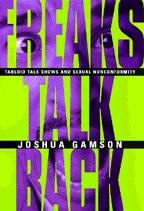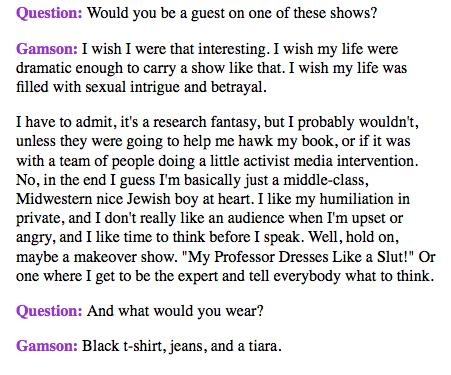My colleagues at OrgTheory are celebrating the award of Guggenheim fellowships to some great sociologists, and they mention one of my favorites, Joshua Gamson. I was reminded of how much I enjoyed Gamson’s first book, Freaks Talk Back, because Gamson’s analysis of tabloid talk shows is laced with interesting questions and examples of strategic self-presentation vs. authenticity.
 Freaks Talk Back (1998) is ostensibly a discussion of the construction and effects of media visibility for gay, lesbian, bisexual, and transgendered guests on TV talk shows, and subsequent effects of this presentation on the larger community.
Freaks Talk Back (1998) is ostensibly a discussion of the construction and effects of media visibility for gay, lesbian, bisexual, and transgendered guests on TV talk shows, and subsequent effects of this presentation on the larger community.
But, I also think of Freaks Talk Back as a great discussion of how talk shows toy with the tension between (1) eliciting genuine emotions and insights from “freaky” guests, (2) within a very predictable arc of discovery-horror-revelation-and forgiveness (my terms). What happens in the horror and revelation stages (my terms again) is important to the audience’s perception of what is authentic.
A hat tip to OrgTheory for linking back to this 1998 interview with Gamson, where he talks about the authenticity of what these shows portray. Gamson in both thoughtful and pithy in his comments, excerpted below.
How much is staged? What’s credible, what isn’t? How do we know what is ‘authentic’?
… (I)t’s easy enough to fake them out. But from the producers’ point of view, the point is less to be credible than to be amusing and at least plausibly true. So in the end, people are playing themselves, extra-big, extra-angry. Fake-real. I think that’s some of the appeal. It’s real, but it’s a show; it’s authentic, but it’s also a performance.
Emotion and Authenticity
An important insight from Gamson’s work– an insight that is independently rediscovered by Joe Pine and Jim Gilmore in their book on Authenticity – is the role of emotion in determining what is “authentic”.
Gamson explains:
The other kind of truth that gets told, I think, is a kind of visceral emotional truth (italics mine) that is quite rare in media culture. The authentic”or authentic-seeming”emotional moment is gold for the shows, and they set things up to increase the chances those moments will arise, and often they succeed.
You can almost see when a switch is flipped for someone, and suddenly they are in the emotional moment”and of course the camera zooms in. I’ve seen the pain of gay, lesbian, and bisexual teenagers”and their pride too”come across stronger on talk shows than anywhere else in media culture, which tends to sanitize emotion. I’ve also seen disgust for gay people”real nasty, nauseated venom”that feels as real as any I’ve encountered in my life. They’re not necessarily pretty, and they don’t last long, but these are important little moments of emotional truth.
Raw Emotion = UnCooked Truth = Authenticity
What happens in these moments of high emotion is that …
the presence of strong emotion verifies and legitimates for the audience that “what is revealed” is a “truth”.
Strong emotion is interpreted as making something real, because we believe that if the emotion is too calculated, smooth, or guarded, that shows that it has already been processed, and so has the thought or “truth” that is communicated with that emotion. Or, said another way, if “what is revealed” or spoken has been manufactured, spun, adjusted, or prepared, this intervention would have smoothed away the emotion too, making the emotion cooked and not raw.
Raw emotion is just that– emotion that hasn’t been cooked or processed. When raw emotion appears with a statement about the self (or the organization) it looks like that statement is as unprocessed as the emotion itself. So the statement looks authentic, by virtue of its concomitant appearance with an authentic emotion.
It may not be real or authentic, but that’s how it looks.
Raw Emotion = UnCooked Truth = Authenticity
—-
And now, just for fun, I add my favorite part of the interview- — where Gamson reveals that he and I have similar media-related fantasy career goals:

I really dig the tiara part.
(Photo from the GLBT Historical Society.)
 I am an organizational consultant, change advocate, and organizational identity/reputation scholar with a PhD in leadership & organizations. I research, write about, and consult with organizations on the relationships between organizational identity, actions, and purpose. I teach Technology Management, part-time, at Stevens Institute of Technology.
My current research focuses on how social technologies in the workplace can drive organizational change, generate meaning, and catalyze purpose. See the
I am an organizational consultant, change advocate, and organizational identity/reputation scholar with a PhD in leadership & organizations. I research, write about, and consult with organizations on the relationships between organizational identity, actions, and purpose. I teach Technology Management, part-time, at Stevens Institute of Technology.
My current research focuses on how social technologies in the workplace can drive organizational change, generate meaning, and catalyze purpose. See the 
Comments on this entry are closed.